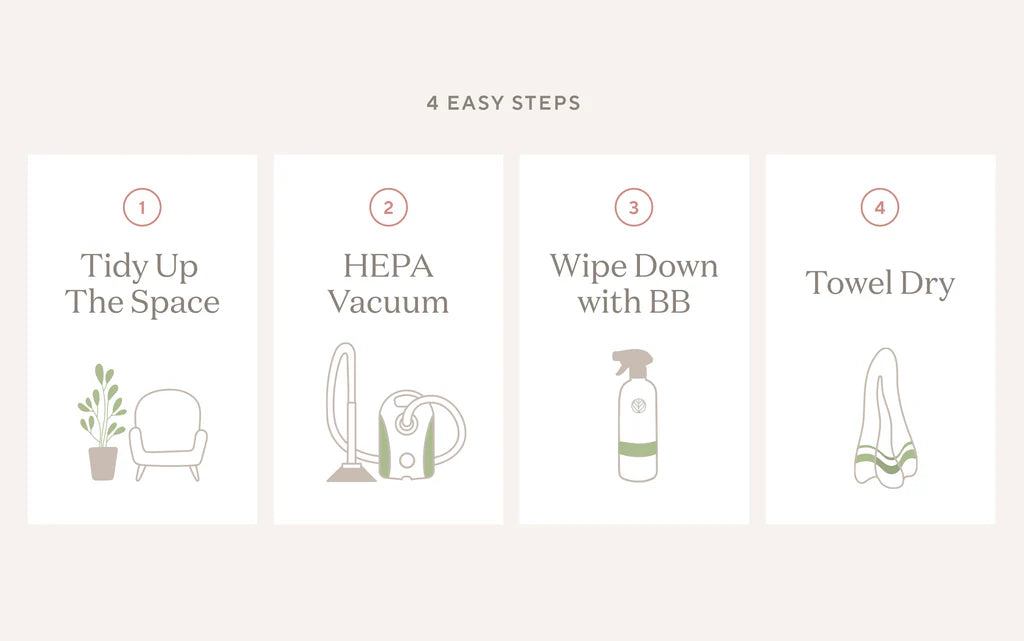Our Deep Cleaning Method
Branch Basics | March 28, 2023

The last step of Toss the Toxins... a thorough, deep clean of your home!
In this non-toxic deep cleaning method, we will explain in detail how to thoroughly clean a room. We recommend doing this process barefoot or in clean socks so that you don’t track toxins around your space. This process will take roughly 2-4 hours for one person to complete one furnished, average sized room. An unfurnished space will take about an hour.
Materials Needed:
- Branch Basics Concentrate
- HEPA Vacuum
- 2 buckets
- Sponge mop (that squeezes out water) or microfiber mop
- 2-3 clean rags, sponges or microfibers
- 1-2 spare towels that you won't mind getting dirty
- Ladder or step ladder to reach the ceiling
- face mask that filters non-oily and oil-based particles (optional, but recommended)
- A friend or cleaning partner (to make things go more quickly!) 😊
Basic Overview

In this non-toxic deep cleaning method, we will explain in detail how to thoroughly clean a room. We recommend doing this process barefoot or in clean socks so that you don’t track toxins around your space as you clean. This process will take roughly 2-4 hours for one person to complete one furnished, average sized room. An unfurnished space will take about an hour.
Here are the four basic steps we will cover in this non-toxic deep cleaning tutorial:
- Tidy up your space
- HEPA vacuum all surfaces in the room
- Wipe all surfaces using Branch Basics. If desired, consider Dry Steam Cleaning Option.
- Dry surfaces with a towel, or ventilate with fans and air-dry
Step 1: Tidy Up The Space

Remove all clutter from the room and only leave what belongs; donate or toss what you do not need. Clutter piles are not only magnets for dust bunnies, but navigating around them makes deep cleaning more challenging.
Step 2: HEPA Vacuuming

Starting with the ceiling and moving down to walls and floors, HEPA vacuum all horizontal and vertical surfaces using careful, overlapping strokes by 30%. Make three passes over each area. Vacuum all surfaces including furniture and in crevices.
Step 3: Wipe Down
Prepare your two buckets for wiping everything clean:
- Your first bucket will be the water with Branch Basics solution: 1 teaspoon of Branch Basics for each gallon of water.
- The second bucket is a rinse bucket: Just fill it with clean water.
Dip your mop in the Branch Basics solution and squeeze as much out as possible. Thoroughly wipe all large horizontal and vertical hard surfaces, starting with ceiling, then walls, then floors.Make three passes over each area.
As you need more Branch Basics solution, first rinse the mop in the clean water bucket, squeeze out the water, then dip again in the Branch Basics solution. You may need to empty the second bucket and refill during this process.
After you have washed ceilings, floors and walls, use your sponge or rag to do the same process to your trim, corners, and all furniture. For any small pieces and all solid, non-porous items such as figurines and lamps, you can first spray the rag with Branch Basics All-Purpose and wipe clean.

Step 4: Towel Dry
Quickly dry off any areas where that may still have extra moisture, particularly wet spots on the walls or floor. You may also want to dry off any objects that you don’t want to leave to air dry.
Cleaning Maintenance
As you can tell, this process is not designed for weekly cleaning. When you thoroughly clean a room using this non-toxic deep cleaning method, you shouldn’t have any reason to go through the process again until the next year. To keep your space clean until then, we recommend:
- Remove your shoes when you enter your home. Shoes track chemical residues and pesticides (not to mention mud or other grime) through your living space, leaving particulates on surfaces and in the air. Remove your shoes and guests to remove theirs.
- Aim to vacuum thoroughly at least once a week. This will help keep down SVOC levels and reduce exposure to particulates. Remove as many sources of SVOCs as you can. When you do vacuum, opt for a sealed HEPA vacuum. HEPA vacuums are much more effective at containing particulates and will not create a dust storm as you try to vacuum and remove dirt and dust.
- Limit clutter as much as much as you can. As we’ve mentioned, clutter piles are the most hospitable homes for dust bunnies, which may be tidy piles of pesticides and chemical residue.
Congratulations on completing the Toss the Toxins course, start to finish!
